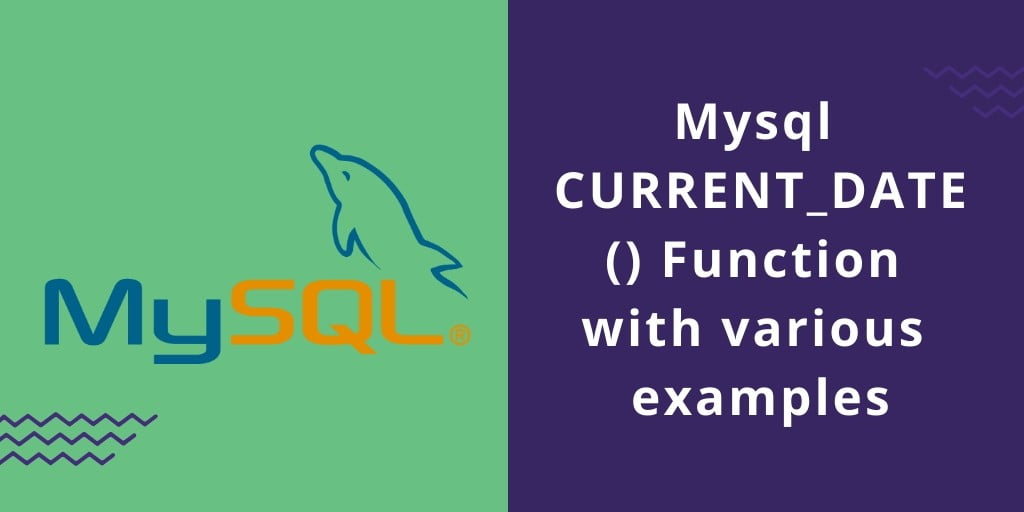MySQL CURRENT_DATE() function; Through this tutorial, we would love to share with you how to use CURRENT_DATE() MySQL with the help of examples.
And as well as, we will show you uses of MySQL CURRENT_DATE() with various MySQL functions such as YEAR(), MONTH(), WEEK(), DAYNAME(), MONTHNAME() etc.
Basically CURRENT_DATE() function returns the current date in various formats, such as ‘YYYY-MM-DD’ or ‘YYYYMMDD’ format.
In our previous tutorial, we have shared a list of MySQL Date functions that are available to work with Date and time.
MySQL CURRENT_DATE() function with Examples
In MySQL Tutorial, The CURRENT_DATE() function returns the current date in various formats, such as ‘YYYY-MM-DD’ or ‘YYYYMMDD’ format, depending on whether the numerical or string is used in the function.
As the name suggest CURDATE() function, basically CURRENT_DATE() function synonym for CURDATE(). Both(CURRENT_DATE(), CURDATE()) functions return the current date as a value in YYYY-MM-DD or YYYYMMDD format.
Syntax:
CURRENT_DATE ()
Examples MySQL CURRENT_DATE() function
let’s take various examples of MySQL CURRENT_DATE() function.

Example-1
let’s take example-1, the below statement will return the current date in ‘YYYY-MM-DD’ format.
SELECT CURRENT_DATE();
Output-1
+---------------------+ | CURRENT_DATE() | +---------------------+ | 2019-07-05 | +---------------------+
Example-2
let’s take example-2, the below statement will return the current date in ‘YYYYMMDD’ format.
SELECT CURRENT_DATE()+1;
Output-2
+---------------------+ | CURRENT_DATE()+1 | +---------------------+ | 20190706 | +---------------------+
Example-3
let’s take example-3, the below statement will return the Day number from current date.
SELECT DAY(CURRENT_DATE());
Output-3
+---------------------+ | CURRENT_DATE() | +---------------------+ | 5 | +---------------------+
Example-4
let’s take example-4, the below statement will return the year number from current date.
SELECT YEAR(CURRENT_DATE());
Output-4
+----------------------+ |YEAR(CURRENT_DATE()) | +----------------------+ | 2019 | +----------------------+
Recommended Post
Example-5
let’s take example-5, the below statement will return the month number from current date.
SELECT MONTH(CURRENT_DATE());
Output-5
+-------------------------+ |MONTH(CURRENT_DATE()) | +-------------------------+ | 7 | +-------------------------+
Example-6
let’s take example-6, the below statement will return the week number from current date.
SELECT WEEK(CURRENT_DATE());
Output-6
+-------------------------+ |WEEK(CURRENT_DATE()); | +-------------------------+ | 26 | +-------------------------+
Example-7
let’s take example-7, the below statement will return the day name of week from current date.
SELECT DAYNAME(CURRENT_DATE());
Output-7
+-------------------------+ |DAYNAME(CURRENT_DATE()); | +-------------------------+ | Friday | +-------------------------+
Example-8
let’s take example-8, the below statement will return the month name from current date.
SELECT MONTHNAME(CURRENT_DATE());
Output-8
+-------------------------+ |DAYNAME(CURRENT_DATE()); | +-------------------------+ | July | +-------------------------+
Conclusion
In this MySQL tutorial, we have discussed MySQL CURRENT_DATE() function with various examples.
Recommended MySQL Tutorials
If you have any questions or thoughts to share, use the comment form below to reach us.
